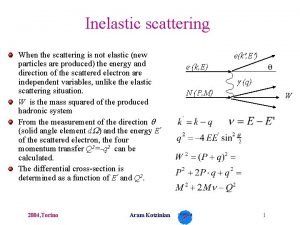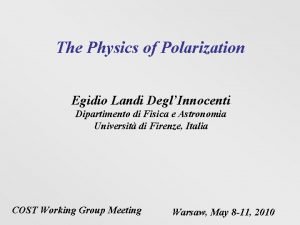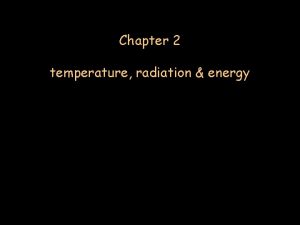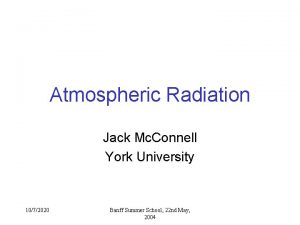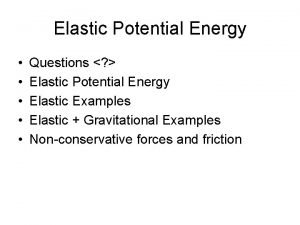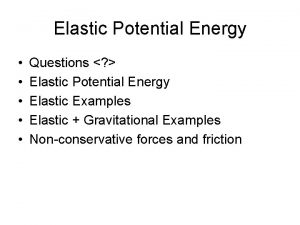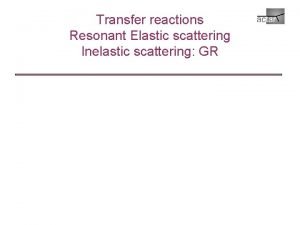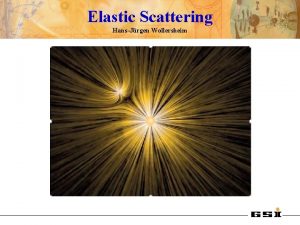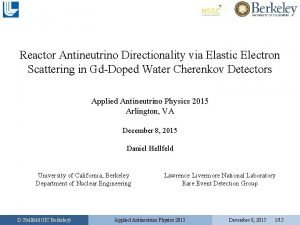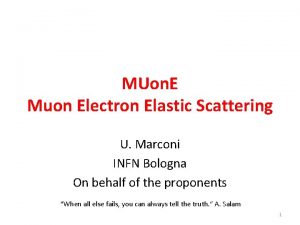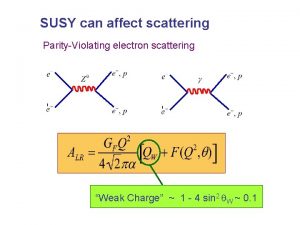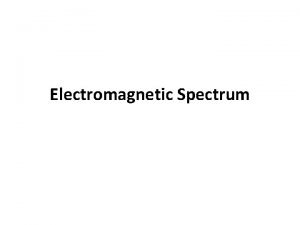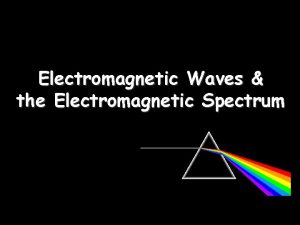Interaction electron solid Elastic electron scattering Electromagnetic interaction



















- Slides: 19

Interaction: electron – solid Elastic electron scattering Ø Electromagnetic interaction between accelerated electrons and electrons in the atom Electron Ø Energy of the scattered electron remains unchanged Atom Ø Occurrence: Electron diffraction (SAED, EBSD) 1

Intensity Interaction: electron – solid Inelastic scattering Ø Loss of energy of accelerated electrons Ø Emission of a continuous spectrum of X-rays Ø Bremsstrahlung 2 Wavelength

Inelastic scattering Ø Excitation of core electrons by accelerated electrons Intensity Interaction: electron – solid Ø The excess energy is emitted as X-ray quantum Ø Characteristic X-ray radiation is produced 3

Interaction: electron – solid Characteristic X-rays Moseley law: Z … atomic number 4

Characteristic X-rays X-ray radiation (electromagnetic wave) with a defined wavelength that is used for X-ray diffraction experiments Chemical analysis (EDX/WDX, X-ray fluorescence) 5 http: //hyperspy. org/hyperspy-doc/current/user_guide/eds. html

Interaction: electron – solid Emission of Auger electrons Ø Ionization of an atom by accelerated electron Ø Emission of a photon (characteristic X-rays) Ø Additional ionization of the atom by the previously emitted photon 6

Interaction: electron – solid Summary Ø Elastic scattering of electrons Ø Inelastic scattering Ø Ø Emission of Bremsstrahlung Emission of secondary electron Emission of characteristic X-rays Emission of Auger electron 7

Interaction: photon – solid Elastic scattering of photons photon atom Ø Electromagnetic interaction between a photon and the electrons in the atom Ø No change of the energy (or wavelength) of the scattered photon Ø Occurrence: X-ray diffraction and X -ray scattering Thomson scattering process 8

Interaction: photon – solid photon electron Compton scattering scattered photon scattered electron Inelastic scattering of photons Ø Interaction of a photon with an electron in the atom, whereby the photon transfers a part of its energy and momentum to the electron Ø Energy of the scattered photon decreases (its wavelength increases) 9

Compton scattering 10

Interaction: photon – solid Absorption of a photon Ø The energy of a photon will be transferred into the solid µ … linear absorption coefficient [cm-1] ℓ … thickness of the absorber [cm] 11

Interaction: photon – solid W … work function Photoelectric effect Ø The photon supplies the energy that is required by the electron to leave the (surface of the) solid Ø The photon is absorbed Ø The probability of the photon absorption depends on the photon energy Ø XPS (X-ray Photoelectron Spectroscopy) 12

Interaction: photon – solid Excitation/ionization of atoms Ø The photon provides the energy required to excite / ionize an atom in the crystal structure (release of a bound electron) Ø The photon is absorbed Ø The released electron produces an electromagnetic wave, which can be scattered by surrounding atoms / electrons Ø EXAFS (Extended X-ray absorption fine structure) Ø NEXAFS - Near Edge X-ray Absorption Fine Structure Ø XANES - X-ray Absorption Near Edge Structure 13

Interaction: photon – solid X-ray fluorescence Ø A photon excites an electron in the solid Ø The photon is absorbed Ø XRF (X-ray fluorescence analysis) Ø The recorded energy spectrum contains the spectral lines of all atoms in the analyzed material 14

Interaction: photon – solid Magnetic X-ray diffraction Ø Non-resonant case: Scattering of X-rays at the spin moments of electrons Ø Resonant case: uses magnetic exchange splitting of unoccupied states near the Fermi edge (resonant exchange scattering) 15

Interaction: photon – solid Summary Ø Elastic X-ray diffraction and X-ray scattering (Thomson) Ø Inelastic X-ray scattering (Compton) Ø Absorption of photons Ø Photoelectric effect Ø EXAFS, NEXAFS, XANES Ø X-ray fluorescence Ø Magnetic X-ray diffraction 16

Interaction: neutron – solid Elastic neutron scattering Ø Interaction between neutron and atomic nucleus neutron Ø Energy and wavelength of the scattered neutron remain constant atom Ø Nuclear neutron diffraction and neutron scattering 17

Interaction: neutron – solid Creation of a phonon (K, W) Inelastic neutron scattering Extinction of a phonon (K, W) Energy: Ø Interaction of neutrons with phonons (lattice vibrations) Ø (1) the neutron transfers part of its energy to the phonon Ø (2) the neutron gains energy through the absorption of the phonon Ø analysis of the lattice vibrations and phonon modes Momentum: 18

Interaction: neutron – solid Magnetic neutron scattering Ø Interaction between the magnetic moment of the neutron (µ = 1, 91 µB) and the magnetic moment of the atom magnetic moment of the neutron magnetic moment of the atom Ø Analysis of the magnetic structures of solids Ø Still more commonly used as the magnetic X-ray scattering 19
 Non elastic scattering
Non elastic scattering Elastic fibers
Elastic fibers Crystalline solid and amorphous solid
Crystalline solid and amorphous solid Evaporation mixture example
Evaporation mixture example Covalent molecular and covalent network
Covalent molecular and covalent network Crystalline solid and amorphous solid
Crystalline solid and amorphous solid Polycrystalline solids
Polycrystalline solids When a solid completely penetrates another solid
When a solid completely penetrates another solid Crystalline or amorphous
Crystalline or amorphous Crystalline solid
Crystalline solid Interpenetration of solids
Interpenetration of solids The example of solid solution is
The example of solid solution is Scattering in a central force field
Scattering in a central force field Scattering matrix
Scattering matrix Properties of scattering matrix in microwave engineering
Properties of scattering matrix in microwave engineering Scattering cross section in nuclear physics
Scattering cross section in nuclear physics Vertical
Vertical Scattering efficiency
Scattering efficiency Rayleigh theory of light scattering
Rayleigh theory of light scattering Photoelectric and compton effect
Photoelectric and compton effect
